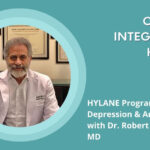Your Biologic Clock
Your Biologic Clock keeps our body rhythms and sleep –wake cycles in synch with the light-day cycle of the earth. It is located in the suprachiasmatic nucleus (SCN) in the hormone control center of the brain, the hypothalamus. When light enters the eye, it activates this part of the brain and reduces production of the sleep hormone (melatonin) produced in the pineal gland of the brain. The light also acts to the release of a variety of other hormones and affects body temperature.
Interestingly, we are programmed to cycle every 24.2 hours―but our exposure to light on a regular basis keeps us linked closely to the earth’s rhythms. Four neurotransmitters (dopamine, norepinephrine, glutamate, and GABA) have roles in controlling the biological clock. Importantly, melatonin cannot be produced if thyroid hormone levels are not adequate. So, if you have sleeping problems, in addition to noting the amount of light you get each day, have your thyroid hormone levels checked.
Generally, the more bright light one gets during the day (especially earlier in the day), the more likely one is to make more melatonin (sleep hormone) during the night, and the less sensitive one is to minor light exposure in the evening or night time.
Light Therapy
Light therapy uses specialized artificial light to treat mood disorders, shift one’s biological clock, or synchronize one’s sleep-wake cycle with the day/light cycle.
It may also be useful in normalizing sleep and behavior in people with dementia, although more research is needed.
The artificial light consists of either a light box which emits up to 10,000 lux of light, much brighter than a customary incandescent lamp, or a lower intensity of specific wavelengths of light from the blue (470 nm ) to the green (525 nm) areas of the visible spectrum.
Application and Timing of Light Therapy
Synchronizing and/or Shifting Sleep/Wake Cycle
If one wants to delay sleep onset, it is best to give light therapy in the hours before bedtime, when core body temperature is beginning to go down. On the other hand if one wants to move sleep earlier in the day/night cycle, it is best to administer light therapy in the second half of the night.
For Mood Disorders
Seasonal Affective Disorder [SAD] is strictly defined as present when a person has a mood disorder which occurs during a particular time/season of the year, and then clears completely at other times of the year. Current criteria require that this occur for 2 years, consecutively. In practice, most people have a seasonal component to their depression, but do not fit strict criteria. Nevertheless, people with a seasonal component do benefit from light therapy. Light therapy is not a substitute for other treatments in non-seasonal depression, and is probably only an adjunct in those who only have a seasonal component to their mood disorder. People with a tendency to oversleep and overeat are more likely to respond to light therapy than others.
If one is treating a mood disorder, light therapy is best given for duration of 30 minutes for every hour one sleeps beyond 6 hours. So for example, if one sleeps 8 hours, they would require one hour of light therapy given one hour before they would normally wake. Since this is unlikely to be done by people who already feel the need for more sleep, it is best to use a dawn simulator light.
Light therapy for mood disorders should usually begin about one week before depressive symptoms tend to begin (based on your past experience), or as soon as they begin. It should be tapered as the day lengthens. The transition dates are around the spring and fall equinox (March 20/21 and September 22/23 each year.)
For Dementia
It is possible that bright light between 7-9 PM may help people with dementia sleep better, have fewer nighttime awakenings, reduce the decrease cognitive functioning and orientation (called ‘sun-downing’) which occurs at night.
What Kind of Light Is Best?
Early studies used 10,000 lux (a measure of light intensity) broad spectrum light, kept one to two feet from the eyes. However, newer data indicates that low lux light (500 lux―which is about 1/10 as strong as the light at dawn) may be just as effective. Short wavelength light (blue part of the light spectrum) seems to be the most active part of the light spectrum, in terms of shifting sleep/wake cycles. Nevertheless most lights available for SAD are 5,000 – 10,000 lux.
Placement of Light [Dawn Simulator]
A dawn simulator is placed above the head (on a headboard), with the light facing the pillow. It is set to go on very gradually–starting about three hours before the normal waking time, and peaking in intensity at the normal waking time. It then shuts off within 10-15 minutes. The advantage of the dawn simulator is that the treatment is administered while you are asleep, and simulates conditions on a normal spring day.
Are There Side Effects of Light Therapy?
Light therapy is similar to drug therapy in that the response depends on dose, timing of dose, and duration of use. There can be mild side effects as well (agitation, insomnia, and rarely nausea or headache). If side effects do occur it is usually best to reduce the amount of light therapy, after discussion with your doctor. One need not look directly into the light to obtain benefits. If you have an eye condition, you should consult your ophthalmologist before using light therapy.




